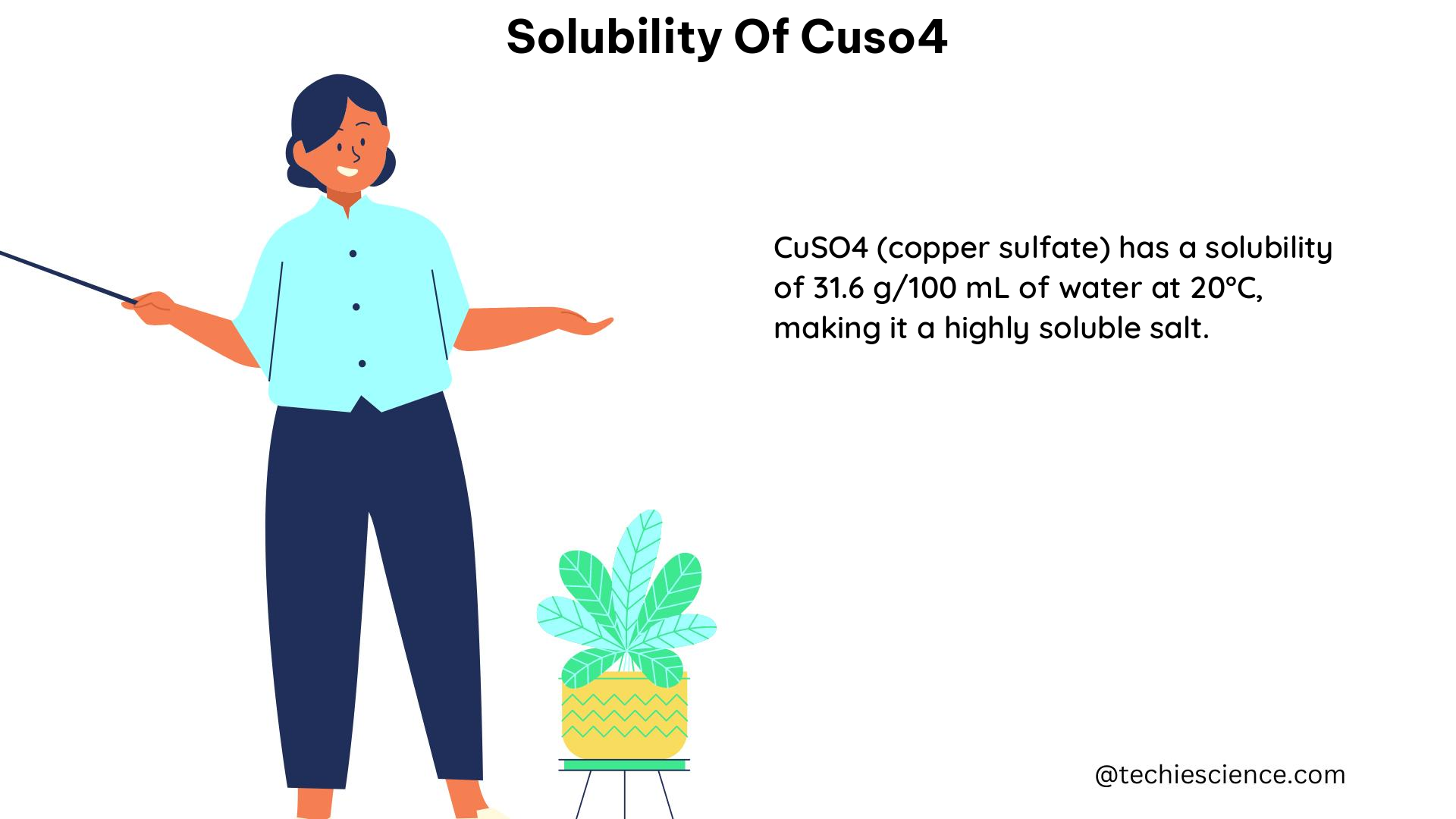The solubility of copper(II) sulfate pentahydrate (CuSO4·5H2O) in water is a crucial parameter in various chemical processes and applications. This comprehensive guide will delve into the intricate details of the solubility of this compound, providing a wealth of technical information to aid science students and researchers.
Understanding the Solubility of CuSO4·5H2O
The solubility of CuSO4·5H2O in water is highly dependent on temperature. At 0°C, the solubility is approximately 269 ± 43 g/L, while at 20°C, it increases to around 332 ± 21 g/L. The solubility undergoes a dramatic rise at 100°C, reaching approximately 1388 ± 602 g/L.
It is essential to note that these solubility values are specific to the pentahydrate form of copper sulfate. The anhydrous form (CuSO4·0H2O) exhibits a different solubility profile, with an average solubility of 145 ± 3 g/L at 0°C, 204 ± 4 g/L at 20°C, and 749 ± 17 g/L at 100°C.
Factors Affecting Solubility
The solubility of CuSO4·5H2O in water is influenced by several factors, including:
-
Temperature: As mentioned earlier, the solubility of CuSO4·5H2O increases significantly with increasing temperature. This is due to the endothermic nature of the dissolution process, where the breaking of intermolecular bonds between water molecules and the subsequent solvation of the ions requires energy input.
-
Hydration State: The solubility of the anhydrous form (CuSO4·0H2O) differs from the pentahydrate form (CuSO4·5H2O), as the presence of water molecules in the crystal structure affects the overall solubility.
-
Purity: The presence of impurities in the copper sulfate sample can influence the measured solubility values. It is crucial to ensure the purity of the compound when determining its solubility.
-
Pressure: The solubility of CuSO4·5H2O is generally not significantly affected by changes in pressure, as the dissolution process does not involve a significant volume change.
Solubility Curve and Recrystallization
The solubility difference between hot and cold water is exploited in the recrystallization process to purify copper sulfate. By dissolving impure copper sulfate in boiling water, which has a higher solubility, and then cooling the solution, most of the copper sulfate crystallizes out, leaving impurities in the solution.
The solubility curve of CuSO4·5H2O in water can be represented by the following equation:
log(S) = -0.5839 + 0.0032T
where S is the solubility in g/L and T is the temperature in °C.
This equation is valid for the temperature range of 0°C to 100°C and can be used to estimate the solubility of CuSO4·5H2O at any given temperature within this range.
Practical Applications and Considerations

The solubility of CuSO4·5H2O has numerous practical applications in various fields, including:
-
Electroplating: Copper sulfate is used as a precursor in the electroplating of copper, where the solubility of the compound affects the deposition rate and quality of the copper layer.
-
Agriculture: Copper sulfate is used as a fungicide and algicide in agriculture, and its solubility determines the effectiveness and application rate of the compound.
-
Water Treatment: Copper sulfate is employed in water treatment processes to control algae growth, and its solubility is a crucial parameter in determining the appropriate dosage.
-
Analytical Chemistry: The solubility of CuSO4·5H2O is used in various analytical techniques, such as gravimetric analysis and precipitation titrations, where the solubility data is essential for accurate calculations and interpretations.
When working with CuSO4·5H2O, it is crucial to consider the following:
-
Hydration State: Ensure the correct identification of the hydration state of the copper sulfate sample, as the solubility values differ significantly between the pentahydrate and anhydrous forms.
-
Purity: Carefully assess the purity of the copper sulfate sample, as impurities can affect the measured solubility values.
-
Temperature Control: Maintain precise temperature control when determining the solubility of CuSO4·5H2O, as small changes in temperature can significantly impact the solubility.
-
Experimental Techniques: Employ appropriate experimental techniques, such as gravimetric analysis or spectrophotometric methods, to accurately measure the solubility of CuSO4·5H2O.
Conclusion
The solubility of copper(II) sulfate pentahydrate (CuSO4·5H2O) in water is a complex and temperature-dependent parameter with significant practical applications. This comprehensive guide has provided a wealth of technical details, including the solubility values at different temperatures, the factors affecting solubility, the solubility curve, and the practical considerations when working with this compound.
By understanding the intricacies of CuSO4·5H2O solubility, science students and researchers can better navigate various chemical processes and applications, leading to more accurate results and informed decision-making.
Reference:
- Lide, D. R. (2004). CRC Handbook of Chemistry and Physics (84th ed.). CRC Press.
- Haynes, W. M. (2014). CRC Handbook of Chemistry and Physics (95th ed.). CRC Press.
- Kucharski, E. S., & Mular, A. L. (1986). Solubility of copper sulfate in water. The Canadian Journal of Chemical Engineering, 64(6), 948-951.
- Linke, W. F. (1958). Solubilities of Inorganic and Metal-Organic Compounds (4th ed.). American Chemical Society.
- Seidell, A., & Linke, W. F. (1952). Solubilities of Inorganic and Organic Compounds (3rd ed.). D. Van Nostrand Company, Inc.

The lambdageeks.com Core SME Team is a group of experienced subject matter experts from diverse scientific and technical fields including Physics, Chemistry, Technology,Electronics & Electrical Engineering, Automotive, Mechanical Engineering. Our team collaborates to create high-quality, well-researched articles on a wide range of science and technology topics for the lambdageeks.com website.
All Our Senior SME are having more than 7 Years of experience in the respective fields . They are either Working Industry Professionals or assocaited With different Universities. Refer Our Authors Page to get to know About our Core SMEs.